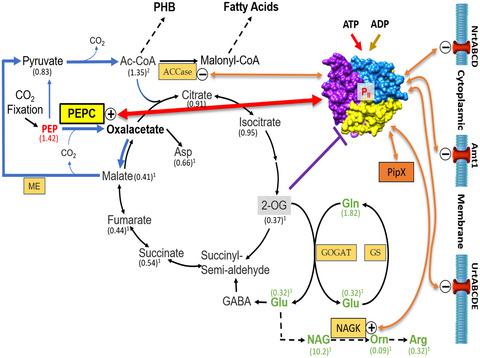当前位置:
X-MOL 学术
›
Mol. Microbiol.
›
论文详情
Our official English website, www.x-mol.net, welcomes your
feedback! (Note: you will need to create a separate account there.)
Phosphoenolpyruvate carboxylase from the cyanobacterium Synechocystis sp. PCC 6803 is under global metabolic control by PII signaling.
Molecular Microbiology ( IF 2.6 ) Pub Date : 2020-04-09 , DOI: 10.1111/mmi.14512 Jörg Scholl 1 , Lisa Dengler 1 , Laura Bader 1 , Karl Forchhammer 1
Molecular Microbiology ( IF 2.6 ) Pub Date : 2020-04-09 , DOI: 10.1111/mmi.14512 Jörg Scholl 1 , Lisa Dengler 1 , Laura Bader 1 , Karl Forchhammer 1
Affiliation

|
Phosphoenolpyruvate carboxylase (PEPC) is the second major carbon‐fixing enzyme in photoautotrophic organisms. PEPC is required for the synthesis of amino acids of the glutamate and aspartate family by replenishing the TCA cycle. Furthermore, in cyanobacteria, PEPC, together with malate dehydrogenase and malic enzyme, forms a metabolic shunt for the synthesis of pyruvate from PEP. During this process, CO2 is first fixed and later released again. Due to its central metabolic position, it is crucial to fully understand the regulation of PEPC. Here, we identify PEPC from the cyanobacterium Synechocystis sp. PCC 6803 (PEPC) as a novel interaction partner for the global signal transduction protein PII. In addition to an extensive characterization of PEPC, we demonstrate specific PII–PEPC complex formation and its enzymatic consequences. PEPC activity is tuned by the metabolite‐sensing properties of PII: Whereas in the absence of PII, PEPC is subjected to ATP inhibition, it is activated beyond its basal activity in the presence of PII. Furthermore, PII–PEPC complex formation is inhibited by ADP and PEPC activation by PII‐ATP is mitigated in the presence of 2‐OG, linking PEPC regulation to the cell's global carbon/nitrogen status. Finally, physiological relevance of the in vitro measurements was proven by metabolomic analyses of Synechocystis wild‐type and PII‐deficient cells.
中文翻译:

来自蓝藻集胞藻属(Synechocystcystis sp。)的磷酸烯醇丙酮酸羧化酶。PCC 6803通过PII信号传导处于全局代谢控制之下。
磷酸烯醇丙酮酸羧化酶(PEPC)是光合自养生物中的第二种主要固碳酶。通过补充TCA循环,PEPC是合成谷氨酸和天冬氨酸家族氨基酸所必需的。此外,在蓝细菌中,PEPC与苹果酸脱氢酶和苹果酸酶一起形成代谢分流器,用于从PEP合成丙酮酸。在此过程中,首先固定CO 2,然后再次释放。由于其中心代谢位置,因此全面了解PEPC的调节至关重要。在这里,我们从蓝藻Synechocystis sp。中鉴定出PEPC 。PCC 6803(PEPC)作为全球信号转导蛋白P II的新型相互作用伙伴。除了对PEPC的广泛表征以外,我们还证明了特定的P II –PEPC复合物形成及其酶促作用。PEPC的活性取决于P II的代谢物敏感性:而在没有P II的情况下, PEPC受ATP抑制,而在P II的存在下其活性超出其基础活性。此外,P II -PEPC复合物的形成是通过ADP和PEPC激活抑制用P II -ATP被减轻在2-OG的存在下,PEPC调节链接到所述单元格的全球碳/氮状态。最后,在体外测量的生理相关性通过的代谢物组学分析证实集胞藻野生型和P II缺陷型细胞。
更新日期:2020-04-09
中文翻译:

来自蓝藻集胞藻属(Synechocystcystis sp。)的磷酸烯醇丙酮酸羧化酶。PCC 6803通过PII信号传导处于全局代谢控制之下。
磷酸烯醇丙酮酸羧化酶(PEPC)是光合自养生物中的第二种主要固碳酶。通过补充TCA循环,PEPC是合成谷氨酸和天冬氨酸家族氨基酸所必需的。此外,在蓝细菌中,PEPC与苹果酸脱氢酶和苹果酸酶一起形成代谢分流器,用于从PEP合成丙酮酸。在此过程中,首先固定CO 2,然后再次释放。由于其中心代谢位置,因此全面了解PEPC的调节至关重要。在这里,我们从蓝藻Synechocystis sp。中鉴定出PEPC 。PCC 6803(PEPC)作为全球信号转导蛋白P II的新型相互作用伙伴。除了对PEPC的广泛表征以外,我们还证明了特定的P II –PEPC复合物形成及其酶促作用。PEPC的活性取决于P II的代谢物敏感性:而在没有P II的情况下, PEPC受ATP抑制,而在P II的存在下其活性超出其基础活性。此外,P II -PEPC复合物的形成是通过ADP和PEPC激活抑制用P II -ATP被减轻在2-OG的存在下,PEPC调节链接到所述单元格的全球碳/氮状态。最后,在体外测量的生理相关性通过的代谢物组学分析证实集胞藻野生型和P II缺陷型细胞。











































 京公网安备 11010802027423号
京公网安备 11010802027423号